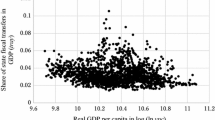Conclusions
This study attempts to fulfill a number of objectives. One is the (possible) reconciliation of two divergent strains of thought concerning the size of government: fiscal illusion and fiscal stress. In this respect, the results show little evidence of fiscal illusion, but provide support for some of the notions associated with the fiscal stress hypothesis, namely the effects of revenue and income variability on the size of government.
Second, we try to provide a more complete specification of the size of government model through the addition of variables measuring the degree of tax exportation and the presence of tax-expenditure limitations. In both cases, the additions prove successful: greater tax exportation significantly increases the level of tax revenues and expenditures; and, and in states where there are statutory limitations on taxes or expenditures, we find lower levels of tax revenues and expenditures. In addition, our findings clearly show that the results one obtains in investigating fiscal illusion are sensitive to the manner in which the model is specified.
Considerable work remains to be done in this area. Obviously, it would be desirable to specify the entire system of equations rather than one reduced form equation in the model. Also, broader and more accurate measures of tax system elasticity would perhaps illuminate the issues more effectively. And finally, the incorporation of modelling the size of government into a more inclusive theory of the public choice of revenues, spending, and government structure would be worthwhile. But these are all beyond the scope of this paper and must be deferred for later study.
Similar content being viewed by others
References
Advisory Commission on Intergovernmental Relations. (1986). Significant features of fiscal federalism, 1985–86 Edition. Washington, DC: ACIR.
Baker, S.H. (1983). The determinants of median voter tax liability: An empirical test of the fiscal illusion hypothesis. Public Finance Quarterly 11: 95–108.
Bergstrom, T.C., and Goodman, R.P. (1973). Private demands for public goods. American Economic Review 63: 280–296.
Borcherding, T.E., and Deacon, R.T. (1972). The demand for the services of non-federal governments. American Economic Review 62: 891–901.
Breeden, C.H., and Hunter, W.J. (1985). Tax revenue and tax structure. Public Finance Quarterly 13: 216–224.
Brennan, G., and Buchanan, J.M. (1980). The power to tax: Analytical foundations of a fiscal constitution. Cambridge: Cambridge University Press.
Clotfelter, C.T. (1976). Public spending for higher education: An empirical test of two hypotheses. Public Finance 31: 177–195.
Craig, E.D., and Heins, A.J. (1980). The effect of tax elasticity on government spending. Public Choice 35: 267–275.
DiLorenzo, T.J. (1982). Tax elasticity and the growth of local public expenditure. Public Finance Quarterly 10: 385–392.
Feenberg, D.R., and Rosen, H.S. (1986). State personal income and sales taxes, 1977–1983. In H.S. Rosen (Ed.), Studies in State and Local Public Finance. Chicago: University of Chicago Press.
Feenberg, D.R., and Rosen, H.S. (1987). Tax structure and public sector growth. Journal of Public Economics 32: 185–201.
Fox, W.F., and Campbell, C. (1984). Stability of the state sales tax income elasticity. National Tax Journal 37: 201–212.
Friedlaender, A.F., Swanson, G.J., and Due, J.F. (1973). Estimating sales tax revenue changes in response to changes in personal income and sales tax rates. National Tax Journal 26: 103–110.
Groves, H.M., and Kahn, C.H. (1952). The stability of state and local tax yields. American Economic Review 42: 87–102.
Hettich, W., and Winer, S. (1984). A positive model of tax structure. Journal of Public Economics 24: 67–87.
Legler, J.B., and Shapiro, P. (1968). The responsiveness of state tax revenue to economic growth. National Tax Journal 21: 46–56.
Misiolek, W.S., and Perdue, D.G. (1987). The portfolio approach to state and local tax structures. National Tax Journal 40: 111–114.
Morgan, W.E., and Mutti, J.H. (1985). The exportation of state and local taxes in a multilateral framework: The case of business type taxes. National Tax Journal 38: 191–208.
Munley, V.G., and Greene, K.V. (1978). Fiscal illusion, the nature of public goods and equation specification. Public Choice 33: 95–100.
Mutti, J.H., and Morgan, W.E. (1983). The exportation of state and local taxes in a multilateral framework: The case of household type taxes. National Tax Journal 36: 459–475.
Nelson, M.A. (1986a). Voter perceptions of the cost of government: The case of local school expenditures in Louisiana. Public Finance Quarterly 14: 48–68.
Nelson, M.A. (1986b). An empirical analysis of state and local tax structure in the context of the Leviathan model of government. Public Choice 49: 283–294.
Oates, W.E. (1975). ‘Automatic’ increases in tax revenues — The effect on the size of the public budget. In R.P. Inman et al. Financing the new federalism. Baltimore: Johns Hopkins University Press.
Oates, W.E. (1985). Searching for Leviathan: An empirical study. American Economic Review 75: 748–757.
Phares, D. (1980). Who pays state and local taxes? Cambridge, MA: Oelgeschlager, Gunn and Hain.
Pommerehne, W.W., and Schneider, F. (1978). Fiscal illusion, political institutions, and local public spending. Kyklos 31: 381–408.
Wagner, R.E. (1976). Revenue structure, fiscal illusion, and budgetary choice. Public Choice 25: 45–61.
White, F.C. (1983). Trade-off in growth and stability in state taxes. National Tax Journal 36: 103–114.
Wilford, W.T. (1965). State tax stability criteria and the revenue elasticity coefficient reconsidered. National Tax Journal 18: 304–312.
Williams, W.V., Anderson, R.M., Froehle, D.O., and Lamb, K.L. (1973). The stability, growth and stabilizing influence of state taxes. National Tax Journal 26: 267–274.
Author information
Authors and Affiliations
Rights and permissions
About this article
Cite this article
Misiolek, W.S., Elder, H.W. Tax structure and the size of government: An empirical analysis of the fiscal illusion and fiscal stress arguments. Public Choice 57, 233–245 (1988). https://doi.org/10.1007/BF00124807
Issue Date:
DOI: https://doi.org/10.1007/BF00124807




